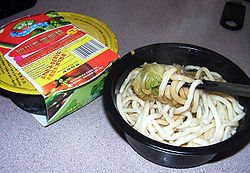
Frozen noodles
Encyclopedia

Chilled or frozen applications are applied to both udon
Udon
is a type of thick wheat-flour noodle of Japanese cuisine.Udon is usually served hot as noodle soup in its simplest form as kake udon, in a mildly flavoured broth called kakejiru which is made of dashi, soy sauce , and mirin. It is usually topped with thinly chopped scallions...
and Chinese-style noodles
Chinese noodles
Noodles are an essential ingredient and staple in Chinese cuisine. There is a great variety of Chinese noodles, which vary according to their region of production, ingredients, shape or width, and manner of preparation...
. For either type, the idea is that just 20–60 seconds of immersion in boiling water is necessary to reach a ready-to-eat state. As of 2001, chilled noodles accounted for sales of ¥400 billion yuan worldwide (approximately $8.5 billion U.S. as of 2001) while frozen noodles accounted for sales of ¥70 billion yuan worldwide (approximately $48.3 billion U.S. as of 2001). A large part of these revenues were accounted for by sale to restaurants.
The production of both chilled and frozen noodle starts with boiled noodles cooked to an optimum state of doneness, generally considered as having a moisture gradient at the surface of the noodles of 80% moisture absorption, and at the core of the noodles of 50% moisture absorption. After boiling, chilled noodles are placed into packaging followed by refrigeration at between 4–10 °C (39.2–50 F). Frozen noodles, by contrast, are flash frozen
Flash freezing
Flash freezing refers to the process in various industries whereby objects are quickly frozen by subjecting them to cryogenic temperatures....
using either air blast technology, a contact freezer or a combination of both, usually at -40 °C for 30 minutes. Both processes induce a swelling of the starch that reduces deterioration and thus extends the noodles' shelf-life.
Frozen noodles have been cited as having advantages over dried noodles, the process tending to make them less sticky, firmer and thicker than their dried counterparts. Both frozen and dehydrated noodles have a longer shelf-life than chilled noodles, which tend to clump after approximately two weeks of refrigeration due to gelatinisation of starch.
While both Frozen and chilled noodles offer convenience for the mass market, and for short preparation times, each have been found to cause loss of optimal texture when tested using alkaline and white salted noodles. In a 2001 published study by D. W. Hatcher and M. J. Anderson of the Canadian Grain Commission
Canadian Grain Commission
The Canadian Grain Commission, also known as the CGC, is a Canadian government department responsible for regulation of the grain handling industry.The Minister of Agriculture and Agri-food is responsible for the Canadian Grain Commission....
, textural attributes of the frozen variety were tested at 1 and 4 weeks after frozen storage, and the chilled variety at the 30 minute and 1, 2 and 7 days marks. Both the frozen and the chilled noodles showed a decline in textural characteristics which increased in severity the further forward in time they were sampled after storage. It was also indicated that the texture of raw frozen noodles, cooked after defrosting, as opposed to precooked and then frozen noodles, fared much better.

